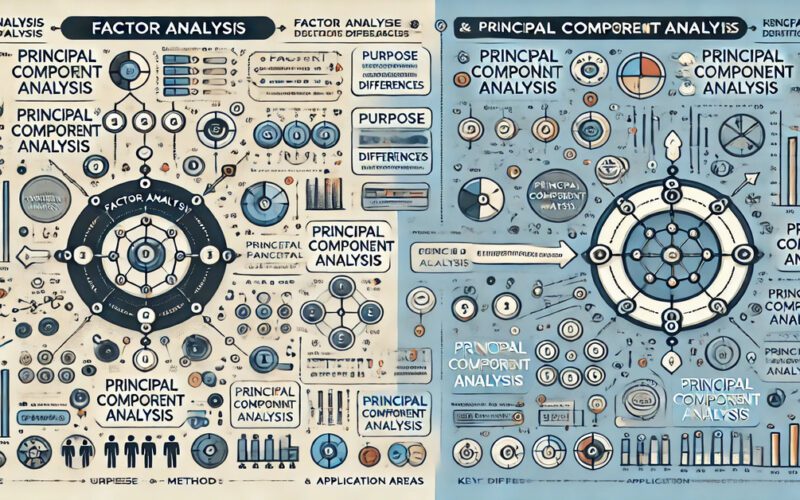Summary: Factor Analysis uncovers latent variables that explain correlations, while Principal Component Analysis reduces data dimensionality, preserving variance. Understanding their differences helps you choose the right tool for identifying hidden factors or simplifying data in fields like psychology, market research, genomics, and finance.
Introduction
Factor Analysis (FA) and Principal Component Analysis (PCA) are powerful statistical techniques use for Data Analysis. While both methods aim to simplify complex datasets, they serve distinct purposes.
Factor Analysis seeks to identify underlying factors that explain observed correlations among variables, whereas Principal Component Analysis focuses on reducing the dimensionality of data while preserving variance.
Understanding the differences between FA and PCA is crucial for selecting the appropriate method for your analysis needs. This blog will explore “Factor Analysis vs Principal Component Analysis,” highlighting their key distinctions and helping you choose the right approach for your Data Analysis objectives.
What is Factor Analysis?
Factor Analysis (FA) is a statistical technique identifying underlying relationship between variables. It uncovers latent factors or constructs that explain observed correlations among variables. By reducing data complexity, FA simplifies understanding of how variables relate to one another through fewer underlying factors.
Objectives and Goals
The primary objective of Factor Analysis is to reveal hidden structures within data by grouping correlated variables into factors. These factors represent underlying dimensions that account for the patterns of correlations observed among the original variables. FA aims to:
- Simplify Data: Reduce the number of variables to a smaller set of factors, making the data more manageable and interpretable.
- Identify Underlying Constructs: Discover latent variables that drive the relationships between observed variables, providing insights into the data’s fundamental dimensions.
- Enhance Theoretical Understanding: Uncover the constructs that explain patterns within the data to support theory development. This can guide further research or refinement of theoretical models.
Common Use Cases and Applications
Factor Analysis provides valuable insights by uncovering the hidden structure in complex data, making it a powerful tool for data reduction and interpretation. Factor Analysis widely used across various fields for different purposes:
- Psychology: In psychological research, FA helps identify underlying traits or factors, such as personality dimensions or cognitive abilities, from questionnaire responses.
- Market Research: Businesses use FA to segment consumers based on underlying preferences or behaviours, allowing for more targeted marketing strategies.
- Health Sciences: Researchers apply FA to understand the underlying factors influencing health outcomes or symptoms, aiding in the development of more effective treatments.
- Education: Educators use FA to analyse student performance and identify critical factors affecting learning outcomes, helping to improve educational strategies.
Read Blog: Statistical Tools for Data-Driven Research.
What is Principal Component Analysis?
Principal Component Analysis (PCA) is a dimensionality reduction technique that transforms a set of possibly correlated variables into a set of linearly uncorrelated variables called principal components.
These components capture the maximum variance present in the original data, with the first component accounting for the largest amount of variance, the second component the next largest, and so on. PCA helps simplify complex datasets by reducing their dimensions while retaining the most critical information.
Objectives and Goals
The primary objective of PCA is to simplify data by reducing its dimensions without losing significant information. The goals of PCA include:
- Dimensionality Reduction: PCA reduces the number of variables in a dataset while preserving as much variance as possible. This makes data easier to visualise and analyse without losing significant information.
- Data Compression: PCA compresses the data by focusing on the most significant principal components, leading to more efficient storage and processing.
- Noise Reduction: PCA filters out noise and less relevant information by concentrating on components that explain the most variance, enhancing the signal in the data.
- Feature Extraction: PCA helps identify and extract the most influential features from a dataset, which can improve the performance of Machine Learning models.
Common Use Cases and Applications
Principal Component Analysis is a valuable tool for simplifying complex datasets, enhancing Data Analysis, and improving model efficiency. Principal Component Analysis finds applications across various fields:
- Finance: Analysts use PCA to identify key factors driving stock market movements and to construct risk models.
- Image Processing: PCA employed in image compression and recognition, reducing the dimensionality of image data while preserving important features.
- Genomics: Researchers apply PCA to analyse gene expression data, uncovering patterns and reducing dimensionality for more manageable data interpretation.
- Marketing: PCA helps businesses segment their customers by identifying key patterns in customer behaviour and preferences, aiding in targeted marketing strategies.
Explore More About: An Introduction to Statistical Inference.
Key Differences Between Factor Analysis and Principal Component Analysis
Understanding the distinctions between Factor Analysis (FA) and Principal Component Analysis (PCA) is crucial when examining statistical analysis. Both techniques simplify complex data, but they serve different purposes and employ different methodologies.
This section explores the key differences between FA and PCA across several dimensions: purpose and objectives, methodology, interpretability, assumptions, and factor versus component scores.
Purpose and Objectives
Factor Analysis aims to uncover the underlying relationships between variables. It identifies latent factors or constructs that explain the correlations observed among variables.
For instance, in psychology, FA might reveal underlying personality traits that influence responses to various questions on a questionnaire. The primary objective of FA is to reduce data complexity by grouping variables into factors that reflect the same underlying construct.
In contrast, PCA focuses on reducing the dimensionality of data while preserving as much variance as possible. It transforms original variables into a new set of uncorrelated variables called principal components.
These components capture the directions of maximum variance in the data. PCA is typically use to compress data, simplify models, or visualise data while retaining key information.
Methodology
FA is based on correlation matrices and uses extraction methods to identify factors. It starts by examining the correlation between variables and then extracts factors that explain these correlations.
The method involves techniques such as Maximum Likelihood Estimation or Principal Axis Factoring. The goal is to determine how many factors needed to explain the patterns of correlations among the variables.
PCA, on the other hand, relies on the eigenvalues and eigenvectors of the data’s covariance matrix. It computes principal components by performing an eigendecomposition of the covariance matrix, which reveals the directions of maximum variance.
Each principal component is a linear combination of the original variables, and the first few components usually capture most of the data’s variance. PCA is purely a mathematical approach focused on variance and does not assume an underlying model.
Interpretability
FA provides factors that can be interpreted as underlying variables or constructs. For example, a factor might represent an underlying dimension, such as “job satisfaction”, derived from multiple survey questions. These factors are often used to make sense of complex data by providing a more meaningful representation of relationships between variables.
PCA produces principal components that are linear combinations of the original variables. While PCA helps reduce data complexity, the principal components are not always easily interpretable. They are mathematical constructs rather than concepts tied to specific latent variables.
For instance, the first principal component might be a blend of various original variables, which can sometimes make its interpretation less straightforward.
Assumptions
FA assumes the presence of latent variables that influence the observed variables. It operates on the premise that the observed variables are manifestations of underlying factors. This approach assumes a model where variables are interrelated through these latent constructs, and the goal is to uncover this underlying model.
PCA assumes linearity in the data and focuses primarily on variance. It does not assume any underlying latent structure but seeks to explain the variability in the data through principal components. The technique is more concerned with representing data in fewer dimensions while maintaining as much variance as possible.
Factor vs. Component Scores
In FA, factor scores reflect the degree to which each observation exhibits the underlying latent constructs. These scores help understand how strongly each factor influences the observations and can be utilised in further analysis or prediction.
PCA provides component scores that represent the projection of the original data onto the principal components. These scores indicate how much of each element is present in the observations and help understand data distribution across the principal components.
Understanding these differences helps select the appropriate method based on the research goals, whether to uncover latent constructs with FA or reduce dimensionality and preserve variance with PCA. Each technique offers unique insights and benefits depending on the analysis context.
Discover: Different Types of Statistical Sampling in Data Analytics.
When Should we Use Factor Analysis vs. Principal Component Analysis?
Despite their similarities, Factor Analysis (FA) and Principal Component Analysis (PCA) are two powerful statistical techniques used for different purposes. Knowing when to use one over the other depends on your research goals.
Factor Analysis is primarily concerned with identifying underlying relationships among variables, while PCA focuses on reducing the dimensionality of data by summarising it into principal components. Below, we explore the ideal scenarios for using FA and PCA and examples of how each can be applied effectively.
Factor Analysis: Ideal Scenarios
Factor Analysis is ideal when you aim to discover the underlying constructs or latent variables that explain patterns in your data. It is commonly used in social sciences and psychology to reduce large variables into more meaningful factors representing broader concepts.
For example, when analysing survey data on job satisfaction, you might find that multiple questions measuring work-life balance, salary, and relationships with colleagues load onto broader factors such as “job fulfilment” and “organisational culture.”
In this scenario, Factor Analysis helps researchers understand which factors most significantly contribute to the broader concept of job satisfaction, reducing the complexity of interpreting many individual variables.
Unlike PCA, which focuses on maximising variance, FA uncovers hidden data structures that are not immediately observable. This is particularly useful when you aim to build a model based on latent variables rather than simply reducing data.
Factor Analysis is also frequently applied in psychometric testing, where the goal is to assess the reliability and validity of tests measuring psychological traits such as intelligence, personality, or behaviour. In psychometrics, researchers often use FA to ensure that different items on a questionnaire or test measure the same construct.
For instance, in a personality test designed to measure traits such as extraversion and conscientiousness, FA can determine whether the items meant to measure these traits are correlated and load onto distinct factors. This helps validate that the test accurately measures the intended personality dimensions and is reliable for further study.
Factor Analysis is particularly beneficial when you expect your variables to be interrelated but want to reduce the noise in your data by isolating the most significant factors driving your results.
Principal Component Analysis: Ideal Scenarios
Principal Component Analysis is best suited for situations where you need to reduce the dimensionality of a large dataset while preserving as much of the original variance as possible.
In fields like genetics, marketing, or finance, datasets often contain hundreds or thousands of variables, making interpreting or visualising the data challenging. PCA condenses these variables into smaller uncorrelated principal components summarising the original data.
For example, in a genetic study analysing thousands of genetic markers, PCA can reduce the dataset to a few principal components that explain most of the variance in the data. This enables researchers to analyse and visualise the data without being overwhelmed by the sheer number of variables.
While PCA doesn’t uncover latent factors like FA, it efficiently reduces data complexity, making it easier to interpret and analyse large datasets.
PCA is the go-to method when your primary goal is data compression without losing much information, especially when dealing with high-dimensional datasets.
PCA is also commonly used in exploratory Data Analysis (EDA) when the aim is to detect patterns and relationships between variables before building more complex models. By identifying the principal components that explain the most variance in the dataset, PCA helps researchers understand the underlying structure of the data.
For example, in market research, PCA can reveal the key factors influencing customer preferences or behaviours from a large dataset of survey responses. Once the principal components identified, researchers can focus on them for deeper analysis, such as clustering customers based on their preferences.
PCA is beneficial for exploratory purposes because it provides a simple and interpretable way to visualise high-dimensional data. By projecting the data onto the first two or three principal components, researchers can create scatter plots that reveal the data’s groupings, trends, or outliers. These insights can then guide the next steps in the research process.
Further Read About: Exploring The Top Key Statistical Concepts.
Conclusion
Factor Analysis (FA) and Principal Component Analysis (PCA) are valuable tools for simplifying complex data but serve distinct purposes. FA identifies hidden relationships between variables by uncovering latent factors, while PCA reduces the dimensionality of data, preserving variance through principal components.
Selecting the correct method depends on your analysis objectives—FA is ideal for exploring underlying constructs, whereas PCA excels in dimensionality reduction. Both techniques offer powerful insights for improving Data Analysis, ensuring that you can draw meaningful conclusions and enhance model performance based on the nature of your dataset.
Frequently Asked Questions
What is the Main Difference Between Factor Analysis and Principal Component Analysis?
Factor Analysis uncovers latent factors that explain correlations among variables, while Principal Component Analysis reduces dimensionality by transforming data into uncorrelated principal components. FA focuses on underlying structures, while PCA preserves variance in the dataset.
When Should You Use Factor Analysis vs Principal Component Analysis?
Use Factor Analysis to identify hidden factors influencing correlations between variables. Choose Principal Component Analysis to reduce data dimensionality while preserving as much variance as possible for more efficient analysis and visualisation.
What are the Key Applications of Factor Analysis and Principal Component Analysis?
Factor Analysis used in psychology, market research, and education to identify underlying constructs. Principal Component Analysis widely used in finance, genomics, and image processing to reduce data complexity and improve visualisation and model efficiency.




